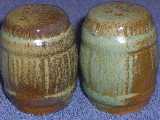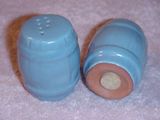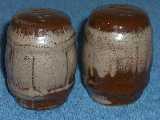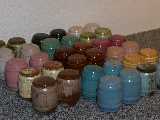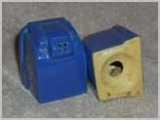

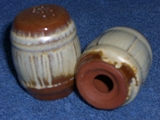
Barrel Shakers #97H: 1950-1961
In the early 1950's John Frank designed the barrel salt and pepper set in conjunction with a group of other similar items. These included a large bean baker, an individual baker, a large pitcher and a large mug. The design never became a full dinnerware line but the group persisted until 1961. The large pitcher stayed in production until 1978.
This design crosses one of the most important production changes ever made at Frankoma, the switch from the tan Ada clay to the brick red Sapulpa clay. Several glazes will be available on both clays. Like most of John Frank’s shakers this design fits the hand very well. The solid rounded design is very resistant to damage.
The barrels were also prime players in Frankoma’s switch from using a cursive “S” to denote salt to using the double-diamond “S”. For most shakers this change occurred near the end of 1952 or at the beginning of 1953. I believe that the 97H barrels were the pioneers in the development of this stylized design.
The double-diamond consists of seven holes, one placed exactly in the middle of the vertical part of the “S” with three above that and three below that forming connecting diamonds. The earliest barrels have seven holes with the central hole in the “S” but the holes do not quite form diamonds. The progression to the double-diamond “S” is so gradual I have found it impossible to cleanly separate the different designs into like groups. Even by the late 1950’s the double-diamond on barrels has a slight distortion on some examples.
I break the barrel family into two types: Type 1, Ada clay and Type 2, Sapulpa clay.
Type 1: Barrel Shakers #97H: 1950-1953, Ada clay.
The 1950 catalog introduces these as available in prairie green, desert gold, onyx black, turquoise blue, sorghum brown, and redbud. The 1951 catalog adds white sand and the 1953 catalog adds clay blue. Note that turquoise was not available in 1952 because of a war-related material shortage. That leaves the turquoise Ada set with only two years of production as the 1953 catalog does not list turquoise as an available glaze.
Type 2: Barrel Shakers #97H: 1954-1961, Sapulpa Red Clay
The popularity of the barrels in the red clay period must have been low as relatively few are available. Additionally they did not make up part of the 1957 semi-centennial celebration group. Yet they should be available in a wide range of glazes: white sand, onyx black, prairie green, desert gold, sorghum, red bud, turquoise, clay blue, terracotta rose, sunflower yellow, brown satin and woodland moss. You can see from the sets shown that my success has been limited to say the least.
The 1958 and later catalogs say that “barrels” are available only in prairie green and desert gold. This must not include the barrel shakers as the brown satin set below is clearly from this period. Also note that terra cotta rose, although not listed is in fact an available glaze.

